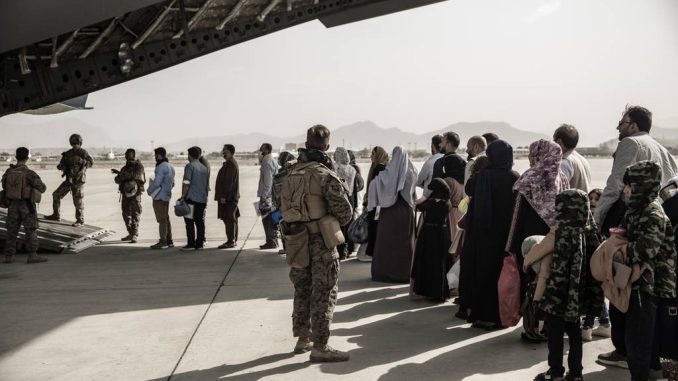

The National Counter-Terrorism Center did not use all available DoD data to fully vet evacuees from Afghanistan before their arrival in the U.S, a new report says. At least four dozen of the roughly 80,000 evacuees have “derogatory information” in their record and are in the U.S. and cannot be located, according to the Defense Department’s National Ground Intelligence Center.
According to the DoD Inspector General report, as of Dec. 13, 2021, an information-sharing agreement had led to NGIC personnel reviewing approximately 58,455 of the 80,404 records it received. The report anticipated that the review of the remaining evacuees would be complete around next month.
The report, released Feb. 15, says that “derogatory information” is defined as information “that potentially justifies an unfavorable fitness or access determination,” requiring further investigation or clarification.
The issue was investigated in the wake of the chaotic U.S. withdrawal from Afghanistan last summer. The report found that the inability to fully vet Afghan evacuees resulted from an international agreement between DoD’s NGIC and “foreign partners,” which prohibits DoD from sharing data with other U.S. government agencies.
As of Sept. 17, 2021, DoD’s NGIC identified 31 Afghans in the U.S. who had “derogatory information” and could only locate three Afghans. While this represents a fraction of the approximately 80,000 Afghans brought to facilities in the U.S., the 31 Afghans were identified prior to full information sharing began between agencies on Sept. 30, 2021.
Further, as of Sept. 29, 2021, 1,236 Afghans left bases in the U.S without completing the health screening, while another 1,358 left upon completion. There is no information in the report indicating that these individuals completed security screenings.
NGIC personnel also said that as of Nov. 2, 2021, 50 Afghan personnel were in the U.S. with information in DoD records that “indicate potentially significant security concerns.” The report did not indicate the current status or location in the U.S. of these Afghans.
Whether the number of Afghans with security concerns or derogatory information has changed remains unclear. DoD would not provide further details and suggested Military Times submit a Freedom of Information request.
Given the large amount of Afghans brought to the U.S., the numbers with questions about them or who cannot be found is not a huge issue, said one of the people who has been helping rescue Afghan allies.
“I don’t think it’s a scandal,” Shawn Van Diver, founder of #AfghanEvac told Military Times. “I think we’re lucky it’s not a scandal. Derogatory information doesn’t mean they’re terrorists. It means there are questions.”
Van Diver, a Navy veteran, has been working feverishly for months to bring Afghan partners and allies to the U.S. He says it’s important to keep this report in context.
“I think you’d be hard-pressed to find in a group of 80,000 Americans 31 that only had derogatory information,” he said.
Once again, Van Diver says, context is key.
“I understand security screening, I know security screening,” Van Diver said. “I know that behind every corner there isn’t a ‘boogeyman.’”
DoD does “not have a role in enrolling, screening, or overseeing” Afghan parolees housed at temporary facilities within the U.S., according to the report, which also notes that Afghan parolees “have the right to leave” at any point after completing compulsory vaccinations and health screenings.
Evacuees from Afghanistan are admitted into the U.S. in two categories: those issued a Special Immigrant Visa and those granted Humanitarian Parole.
Those granted an SIV must have worked on a U.S. base in Afghanistan or have served as a translator or interpreter off base for at least one year. They must also demonstrate an “ongoing threat” due to their employment by the U.S. According to the report, approximately 34,500 SIVs have been provided under this program since 2014.
“Parolees” are not enrolled in the SIV program but are admitted into the U.S. for two years for “urgent humanitarian reasons.” The report contains no data on the number of parolees admitted into the U.S. during an evacuation that flew some 120,000 people out of Kabul during the waning days of U.S. involvement in Afghanistan.
While Afghans who entered the U.S. during the evacuation from Kabul were not fully vetted before their entry, interagency partners took steps to mitigate this issue once it was fully identified. Beginning on Sept. 30, 2021, the NGIC entered into an information-sharing agreement with the Department of Homeland Security and Customs and Border Patrol to “complete the review.”
“I’m glad they figured this out,” Van Diver said. “It sounds like by the end of March they’re going to get through everybody, and that we’ve solved the problem now.”
James R. Webb is a rapid response reporter for Military Times. He served as a US Marine infantryman in Iraq. Additionally, he has worked as a Legislative Assistant in the US Senate and as an embedded photographer in Afghanistan.


Be the first to comment